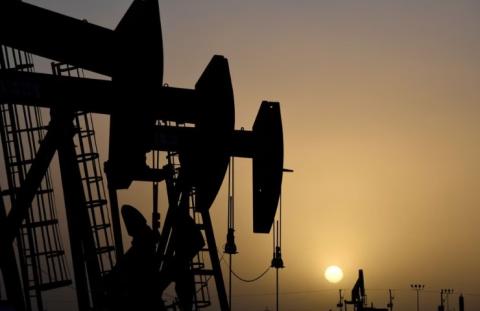
he US shale industry was forecast to deliver record high oil production this year. Only a few months ago the Permian basin was expected to increase its oil output to a new high of 4.8 million barrels per day, on the way to spurring the entire US market to a record daily output rate of 9 million bpd in 2020.
The Permian, North America’s largest shale basin, has been one of the biggest drivers of a shale oil boom that helped make the United States the biggest oil producer in the world, ahead of Saudi Arabia and Russia.
Instead, the region – which stretches from western Texas to eastern New Mexico – has endured its biggest one-month production decline in history. Now observers expect to see a string of oil-well closures, rising debts and bankruptcies as the coronavirus pandemic slashes demand for crude and threatens to wipe out hundreds of startup frackers. Suddenly, reaching 9 million bpd has become highly unlikely.
The impact of the virus has slashed demand for oil across the globe, triggering a race to fill the world’s remaining storage facilities with unwanted crude to avoid shutting down wells entirely In the US, this has forced producers to pay customers to take their barrels, and caused the worst price collapse in market history.
“The current price environment is more or less a complete disaster for the majority of shale companies,” says Artem Abramov, head of global shale research at the consultancy Rystad Energy. “At $30 a barrel, many companies would be able to adapt gradually. But at $20 a barrel, many players – especially those with poor balance sheets – will struggle financially.”
The benchmark price of US crude, known as the West Texas Intermediate (WTI), crashed below zero for the first time last week for May deliveries, and the price for June dropped by a third to just over $15. The rest of the price curve for 2020 shows prices under $30 a barrel – well below the $55 that most US producers need to break even.
The US largest storage facility – at Cushing in Oklahoma – is already two-thirds full and the remaining capacity is understood to have been snapped up by oil traders and brokers. Meanwhile, off the US coast, supergiant oil tankers – each filled with around 2 million barrels of crude – have been paid to stand idle as makeshift storage. Oil producers without storage space have limited options: sell crude at a loss to those still willing to take it, or shut down oil wells and risk financial ruin.
“There are no good answers for the industry in a $30-per-barrel environment,” says Stephen Richardson, an analyst at Evercore ISI. “Let’s not fool ourselves: it’s all uneconomic and likely to stay that way.”
Abramov says: “Market forces will ultimately regulate the industry in a very brutal manner, forcing massive ‘shut-ins’ [well closures] across the country before the market imbalance can improve.”
The crash threatens to change the face of the industry, say experts. The number of fracking projects in America’s shale heartlands has already fallen by two-thirds as oil producers struggle to find buyers for their crude, or space to store it.
Fracking, also known as hydraulic fracturing, involves pumping water, chemicals and sand underground at high pressure to fracture tightly packed shale rock and release trapped oil and gas. It is a controversial method, with environmental groups warning that it could pose a health hazard by poisoning water aquifers – on top of producing more carbon-intensive fossil fuels. But it has made the US a powerhouse in oil and gas production once more.
Continental Resources, the largest oil producer in North Dakota, has reportedly stopped all drilling and shut in most of its wells in the state’s Bakken shale field. The company, owned by billionaire Harold Hamm, is understood to have told customers it will not be supplying oil after the collapse in oil markets last week.
The US oil giants ExxonMobil and Chevron have also set out plans to rein in production and spending. Exxon will cut planned spending by 30% or $10bn (£8.1bn) this year, while Chevron will cut spending by a fifth, or $4bn, compared with last year.
The downturn is likely to hit the thousands of small, sometimes family-owned, US fracking companies, which will be forced into administration or into mergers with more financially resilient rivals.
“This will be oil’s last dance for many US producers, as the Trump administration’s efforts to save the shale industry will fall short,” says Konstantinos Venetis, a senior economist at research firm TS Lombard. “North American shale oil producers will be forced to shut in very soon and most of the smaller players will not be able to survive this low-price and dismal-demand environment.”
President Trump is preparing to use treasury funds to buy US oil to store in the government’s strategic reserves, and is understood to be considering blocks on all imports of crude from Saudi Arabia which are already en route. The measures may offer respite to a few producers but are too little too late, analysts say.
The industry cannot expect the same help from investors that was offered following the 2015 oil market crash either. Investors ploughed about $50bn into the industry in 2016, but rising debt and low returns have now sharpened investor expectations and eroded their appetite for risk. In February Moody’s, the credit rating agency, warned that a “staggering” $86bn worth of shale-industry debt was due to be repaid by 2024.
“Even before the oil price crash, the business models began to change. Investors historically provided a lot of capital to the industry to finance the capital growth. Last year, they began asking these companies to come up with more disciplined and balanced capital programmes and focus more on profitability,” Abramov says.
The companies that survive will be the leanest left standing, he adds. “It won’t be the same industry once prices recover.”











